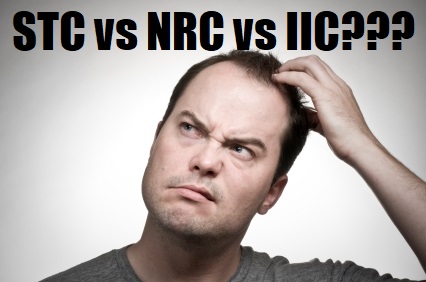STC (Sound Transmission Class) represents a material or product’s ability to block sound from travelling through a wall, ceiling, floor or other building assembly – in other words, to stop airborne noise transferring from place to place. It is the most common sound measurement system in North America – that’s why you’ll see it associated with so many soundproofing products…
The higher the STC rating, the better a material’s ability to block sound. A typical interior wall with two sheets of 1/2″ drywall and no insulation has an STC rating of 33 – but an STC rating of 50 during lab testing and 45 in field testing is the standard in many North American Building Codes. To achieve an even higher STC rating, use products like our Resilmount Sound Isolation Clip system.
A limitation of STC, however, is that it only measures certain frequencies – between 125Hz-4000Hz. This means it doesn’t accurately capture how well a material blocks low frequency sounds – those below 125Hz. This includes common noises that come from airplane engines, large trucks, and heavy equipment.
Green Glue is a cost-effective, easy-to-use product that you can add to your soundproofing assembly to reduce low frequency sound transmission. At Hush City Soundproofing, we carry dozens of products to help reduce the STC rating in your home, apartment, condo, office, man cave, ect.

In 2015 the Canadian National Building Code introduced a whole new sound transmission class, one strictly for flanking sound. For separating partitions, one major factor that causes variance between lab results and real-world performance is flanking transmission, which is noise that transmits to adjacent units or rooms through duct work, windows, hallways or even via a building’s structure. Where flanking noise is an issue, even a partition with an excellent STC rating can have little effect on the overall noise level in an adjacent suite. However, the Apparent Sound Transmission Class (ASTC) includes all paths to rate the overall suite-to-suite noise transmission.

Now you know about STC, but what about NRC?
NRC (Noise Reduction Coefficient) measures the amount of energy absorbed when it strikes a particular surface – in other words, how well something absorbs sound within a given space. It is measured between 0 and 1. An NRC rating of 0 indicates perfect reflection, meaning a material bounces 100% of the sound back into the room. An NRC rating of 1 indicates perfect absorption, meaning a material soaks up 100% of the sound – almost like a “sound sponge”. Our DeAmp Transparent Sound Absorber Panels take highly reverberant glass, with an NRC of 0.05, to an NRC of 0.50.
Now it’s clear how STC and NRC differ. But these both deal with airborne sound – what about vibrational sound?
IIC (Impact Isolation Class) measures a floor assembly’s ability to absorb impact sound – like footsteps. It’s represented with an integer, or whole number. A larger number means more impact sound is being blocked. The number is calculated based on sound reduction in 16 frequencies from 100 to 3150 Hz. Bare 150 mm concrete has an IIC of 25; many building codes require a minimum IIC of 50; high rated underlayment, like our ISO-SEP PM that delivers an IIC of 62 for one layer and an IIC of 64 for two.

Blocking and absorbing both airborne and impact sounds are key components to any soundproofing construction project. Now you know how a material’s ability to affect these changes, and the difference between STC, NRC and IIC.
Share blog:
Sharing is caring!


5 thoughts on “STC, NRC & IIC – What’s The Difference???”
Comments are closed.